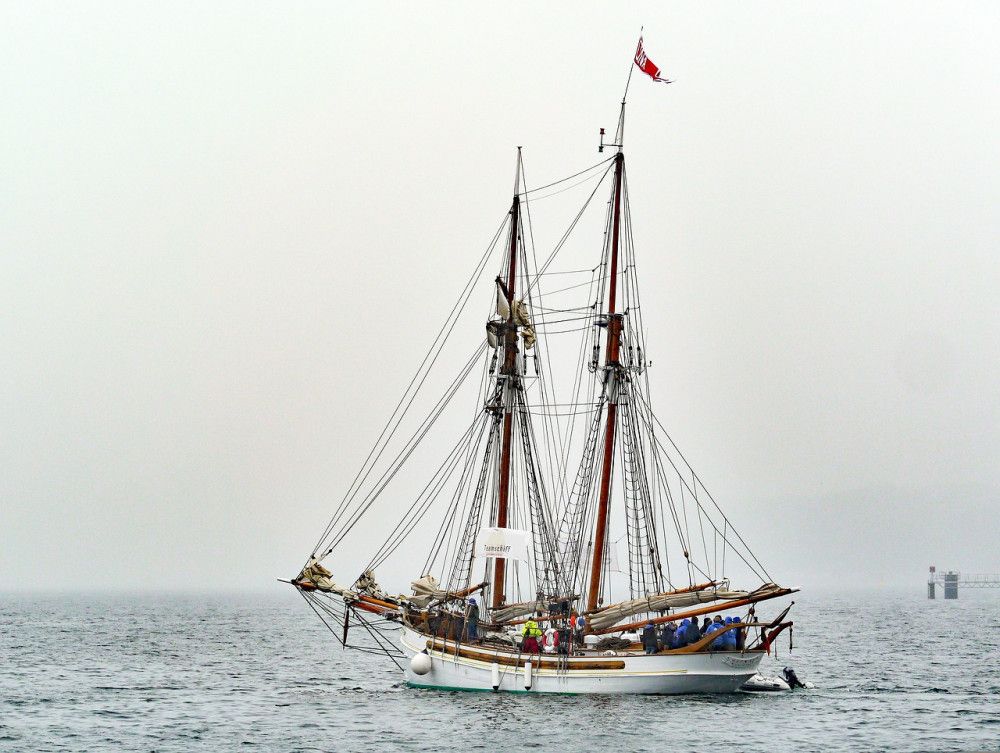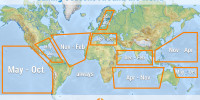How Much Fuel Does a Sailboat Use?
Whenever I dream about long passages, I always wonder how much fuel a sailboat uses. I want to know how much fuel I should bring to carry on. So I crunched the numbers and in this article I'll share my results with you.
How much fuel does a sailboat use? Typically, an average sailboat uses between 1 - 2 gallons per hour. Small sailboats with smaller engines will use about 0.5 - 1 gallon per hour. Large sailboats use between 2 - 3 GPH. Of course, fuel consumption greatly varies with different engine sizes and water and weather conditions.
I'll go into the different factors that affect fuel consumption below. But first, let's get some ballpark figures for different sailboat sizes.

Fuel Consumption for Different Sizes
We measure fuel consumption in Gallons Per Hour (GPH), because the time the engine is running is the only fixed variable here. The distance you cover isn't fixed at all. Most sailboats cruise at a speed of 4 - 8 knots under engine. So the range on one hour of motoring can be anywhere from 4 - 8 nautical miles.
Of course, the size of the boat (and engine) and fuel consumption are related. So let's take a look at what different sizes use on average:
- small sailboats use on average 0.5 - 1 GPH
- mid-sized sailboats use on average 0.9 - 2 GPH
- large sailboats use on average 1.8 - 3.3 GPH
Larger 50HP engines may use up to 2.5 GPH if the conditions are bad and you max it out at, let's say, 8 knots.
Let's get a bit more detailed even. I want to know a range for each engine size. I've found the average fuel consumption in the Yanmar manual.
- Yanmar uses an average fuel consumption of 170 grams per hour per horsepower. - I want to remind you that these are the manufacturer's numbers, so they're probably optimistic.
- So I've also added a more conservative estimate, based on 250 grams per hour per horsepower.
So if you want to calculate your engine's fuel consumption, simply multiply 170 or 250 with the amount of HP. The number is in liters, you have to convert it to gallons.
Here are the manufacturers estimates:
| Engine power | US | Liters |
|---|---|---|
| 10 HP | 0.5 GPH | 1.9 LPH |
| 20 HP | 0.9 GPH | 3.4 LPH |
| 30 HP | 1.4 GPH | 5.1 LPH |
| 40 HP | 1.8 GPH | 6.8 LPH |
| 50 HP | 2.3 GPH | 8.5 LPH |
Here are my estimates for bad conditions:
| Engine power | US | Liters |
|---|---|---|
| 10 HP | 0.7 GPH | 2.5 LPH |
| 20 HP | 1.3 GPH | 5 LPH |
| 30 HP | 2 GPH | 7.5 LPH |
| 40 HP | 2.6 GPH | 10 LPH |
| 50 HP | 3.3 GPH | 12.5 LPH |
Factors That Affect Fuel Consumption
As you can see, fuel use widely varies. There are a lot of factors that determine how much your engine actually burn. Some of them are:
- engine size, type, and power
- hull type and shape
- wind direction
- water conditions
Engine size and power - Larger engines use more fuel. But if you're engine is too small, it could potentially use more fuel. The engine has to work too hard making it rev up (it runs on maximum RPM), burning more fuel. Most of the times people have too big of an engine, and sailboats don't require very large engines. But if you're on the open sea and have a large boat (let's say 40' and up), you want something stronger to deal with the current and wind. Most sailboats are fine with a 30HP engine in most circumstances.
There are some other engine factors, like type the number of cylinders. 2-stroke engines are more powerful but also use a lot more fuel for example. The right size propellor is also important.
If you want to read more on how to choose the right engine size, I've written this short guide on calculating the right size. You can find it here.
Hull type and shape - The shape of the hull determines how much water it displaces. The bulkier the shape, the more water it has to push away, so the more fuel it uses. Also, multihulls displace a lot less water, making them way more efficient. You'll see when you drive a catamaran: it uses WAY less fuel. Flat bottom boats use even less (but are less appropriate for sailing).
Wind direction - Driving straight into a headwind could almost double fuel consumption. Strong winds create high waves which will cause your fuel economy to sink.
Water conditions - As mentioned, high waves are not good for fuel consumption. If you have to head into a strong current, that's not good as well. Very strong (ocean) currents can also double the burn rate.
How To Optimize Fuel Economy
If you need to save your fuel, but you need to get out, for example in an emergency, you want to make sure you get as far as possible as fast as possible. So how to make it happen?
Don't drive at hull speed. This will cause the engine to rev up to maximum RPM. Engines are most efficient between 75-85% of their maximum RPM. It really improves mileage a lot if you take it down a knot.
Find the right course. Take the wind direction and current into account. Just as you would while sailing (but don't go overboard with this either).
Reduce the weight. If you carry ballast, now is the time to unload it. Lowering weight means a lot more range on that tank.
Pick the right engine size. Don't overpower and don't underpower your boat. You want your engine to run at the optimal RPM.
Choose the right prop size - The right propellor is crucial to get an efficiently-running motor. Too small and the engine will rev up in the red, too large and the engine won't even come near the sweet spot.
Make sure your hull is clean. A clean and waxed hull really helps with reducing friction from the water, so it increases your mileage.
Don't drive at maximal hull speed. If you have the right engine size, the optimal speed should be about 2/3 of the maximum hull speed.
Want to know the maximum hull speed for different boat lengths? Check my article with lots of examples here.
If you want to find the sweet spot for your motor, you need to find the specific fuel consumption curve of the engine (SFC) and also the propulsion efficiency curve. The best advice I can give here is to ask the salesperson you've bought the engine from. He or she usually has the data.
Taking it easy on speed is also better for the engine, so it will last longer and require less maintenance.
But it might not be worth your time. Sometimes you just want to get out there fast. Sure, by cruising at 6 knots instead of 8, you increased your range with (let's say) 10%, but you've also increased your drive time by dozens of hours.
How Much Fuel Should I Carry?
Some sailors would argue the more the better. And sure, it's tempting to rev up the engine once you reach 3 or 4 knots. Especially if you have a long way ahead of you. But more fuel means more weight means more fuel consumption. So what's the sweet spot?
I'd say the ideal range for ocean passage is about 400-500 NM of fuel. The average motoring speed of sailboats is 6 knots. That translates to roughly 60-80 hours of motor time. At 2 GPH, you would need about 125-160 gallons of fuel.
If your boat is a bit more efficient, let's say 1 GPH, you would need about 60 - 80 gallons.
Related Questions
How Many Gallons of Fuel Does a Sailboat Hold? On average, a sailboat holds anywhere between 30 - 60 gallons of fuel on board. This provides a theoretical range of 350 - 600 nautical miles at a fuel consumption of 0.5 GPH. In practice, fuel consumption averages at 1 GPH, making the range 200 - 300 NM.
Did you find the answer to your specific question?
👍 30 👎 2



Comments
shane johnson
man i had a real hard time trying to find real info on fuel regards sail and power vessels. ime tearing my hair out deciding on a liveaboard for me over here in australia, i will be working sometimes so at a marina and other times out on the reef or werever the fish are. ime looking at a great fitted out light 50 footer with 2 yanmar 40 hp in her at the same time a steel 40 fter with sails and 2 50 hp diesels in her.all sails are furling including the mainsail and in my head i think sail would be a safety advantage wouldnt it? but the other is top shelf with room fitout electrics and weight. being 8 ton the steel being 12 ton.
Shawn Buckles
Hi Shane, glad you find the article helpful.
If you’re a sailor, I’d say sails are definitely a great backup to have. Personally, I’d only go for the one with sails if I plan on actually sailing the vessel. If not, I’d opt for the larger, fully-outfitted one.
Well, in any case, you’ll have plenty of horses!
Scott
Great article. I did spot a calculation error in the fuel numbers. Try applying the specific gravity of diesel fuel to convert from mass in grams to liters of diesel fuel. A typical number for diesel is .823 g/L.
Multiply the results in the tables above by 1/.823 = 1.215 to get the correct consumption results.
e.g. 10 HP @ BSFC of 250g/hr would be 2.5Kg/hr * 1.215 = 3.04L/hr.
David van Niekerk
Dankie Shown Buckles
I’m from the Boland (South Africa). I find your article very OK. I know now the fuel consumption of a normal sailboat@ 8kn (14.64km/u) is about 5.1 LPH. BUT, wat is the fuel consumption of a catamaran or even the newe hydrofoil’s?
(A small aircraft is about 10+ LPH @80-100km/h)
Leave a comment